Abstract
Genes containing the cauliflower mosaic virus 35S promoter fused to open reading frames coding for tomato proteinase inhibitor I, tomato inhibitor II, and potato inhibitor II were expressed in transgenic tobacco plants. Inhibitor I and II proteins were identified by immunoblotting and quantified by immunoradial diffusion. Both inhibitors exhibited the molecular weights found for the native proteins in their natural environments. Extracts of leaves from transformed plants contained inhibitory activities against trypsin and chymotrypsin that reflected the levels of inhibitor I or II protein present. The results demonstrate that in tobacco leaves the introns of both inhibitor I and inhibitor II genes were excised correctly and that pre and prepro inhibitor I and II proteins were correctly processed. Growth of Manduca sexta larvae (tobacco hornworms) feeding on leaves of transgenic plants containing inhibitor II, a powerful inhibitor of both trypsin and chymotrypsin, was significantly retarded, compared to growth of larvae fed untransformed leaves. Levels of inhibitor II protein as low as 50 micrograms/g of tissue moderately affected larval growth, whereas levels above 100 micrograms/g severely reduced growth. The presence of tomato inhibitor I protein, a potent inhibitor of chymotrypsin but a weak inhibitor of trypsin, in transgenic tobacco leaves had little effect on the growth of the larvae. These experiments indicated that trypsin inhibitory activity, but not chymotrypsin inhibitory activity, was mainly responsible for the inhibition of larval growth.
Full text
PDF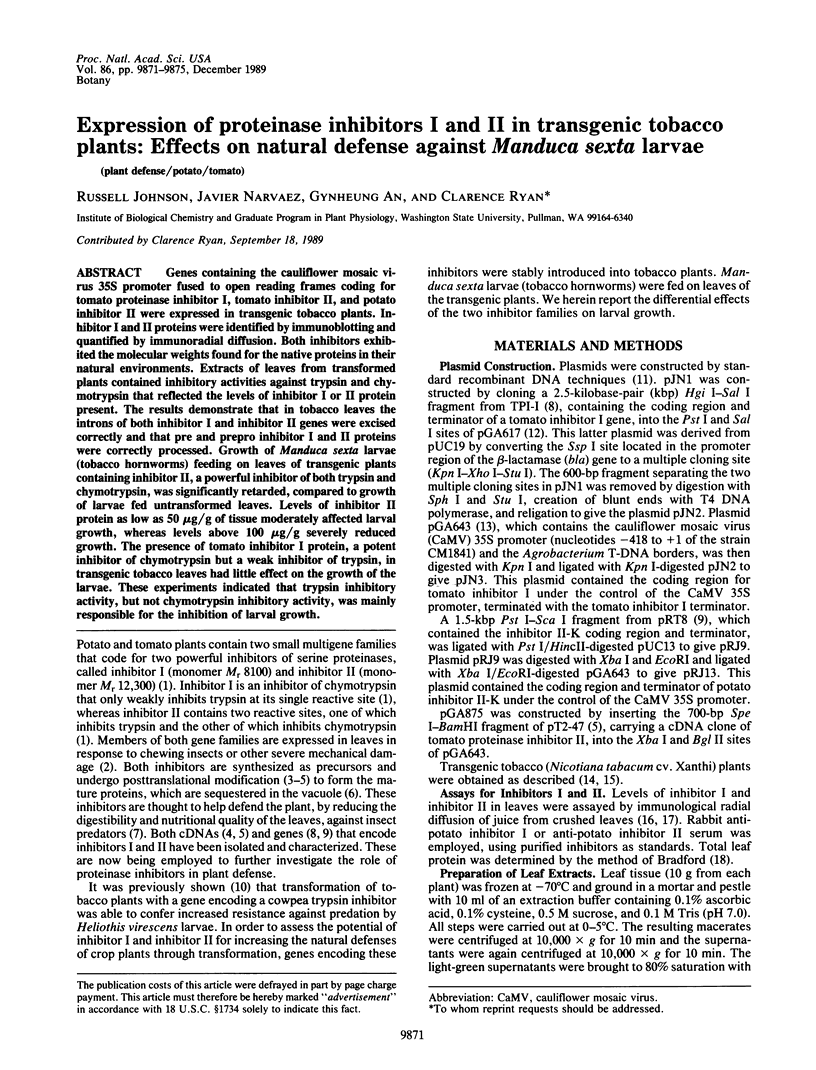
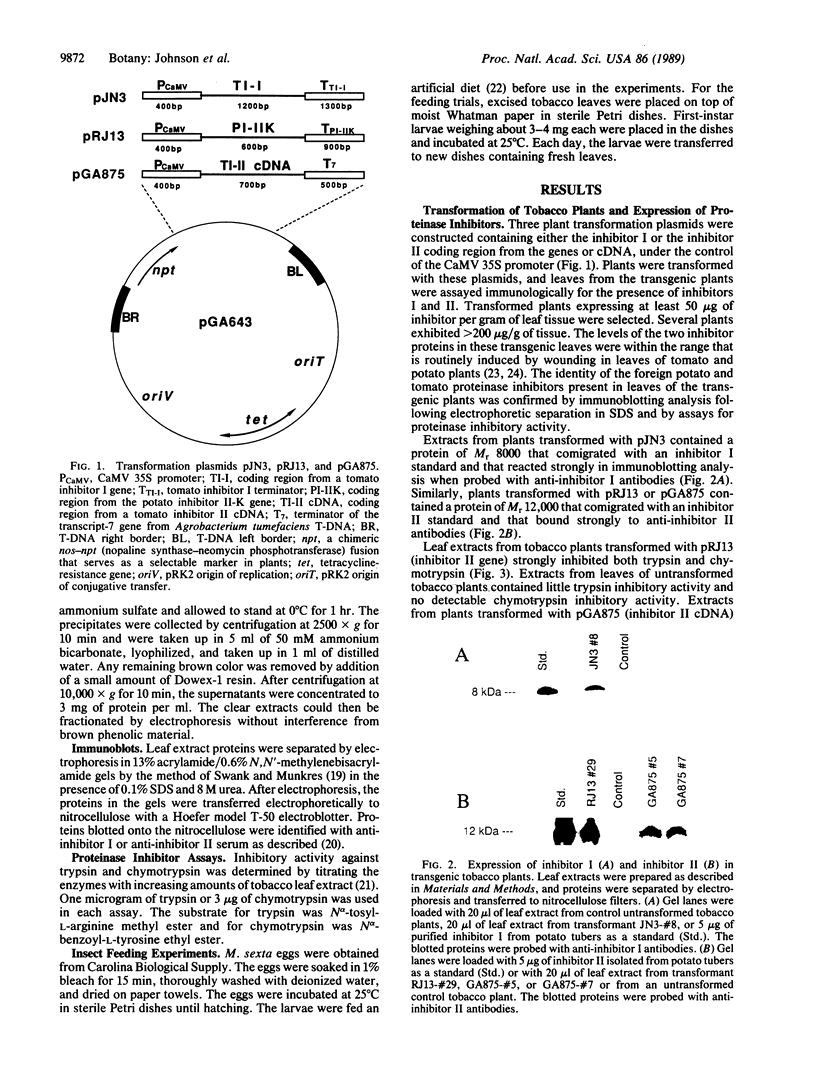
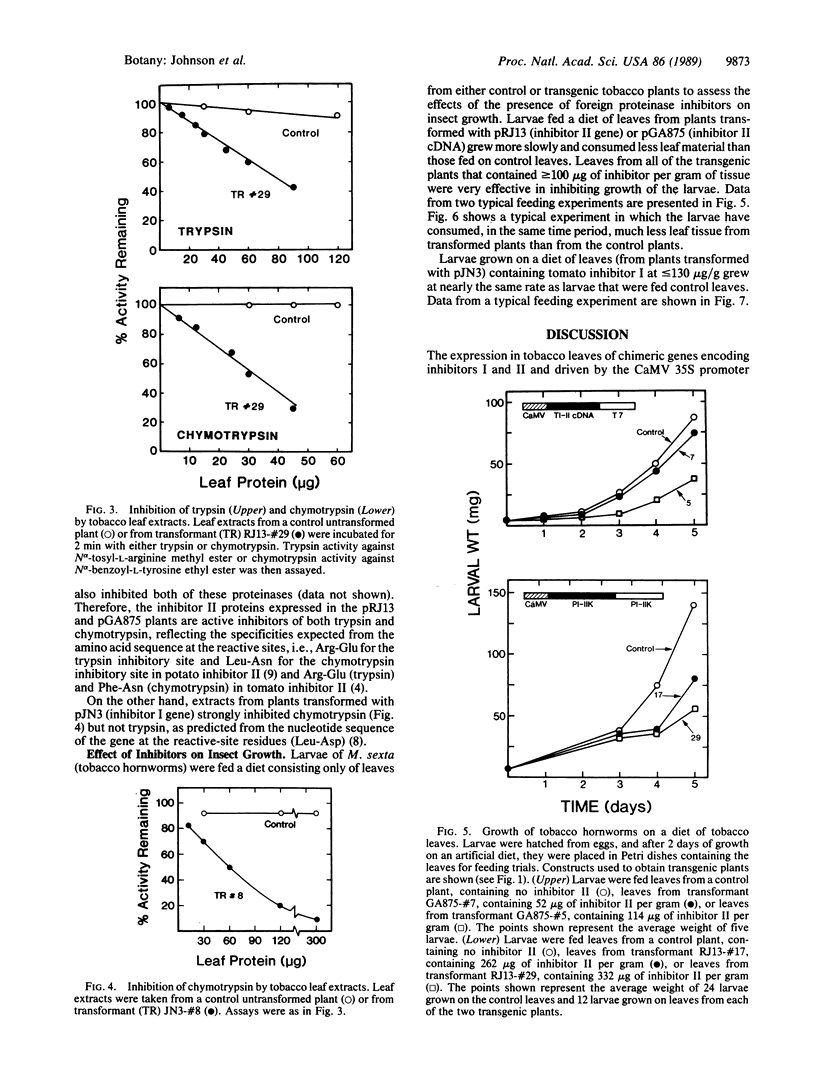
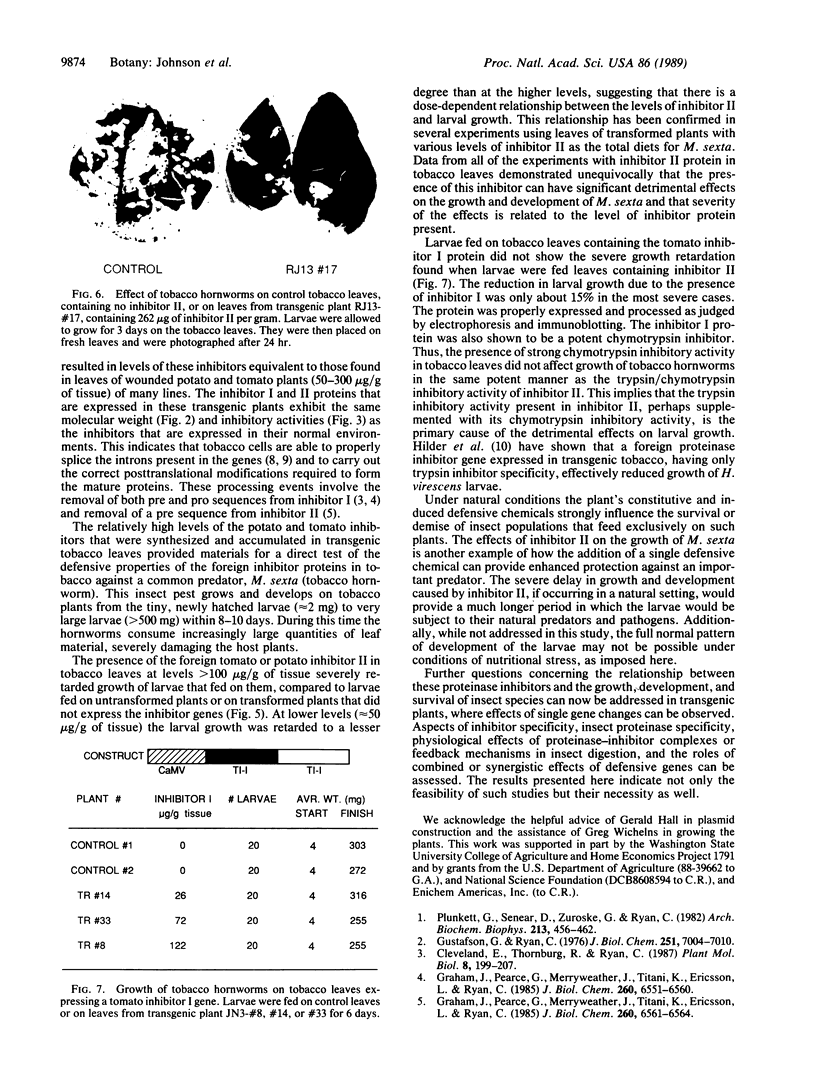
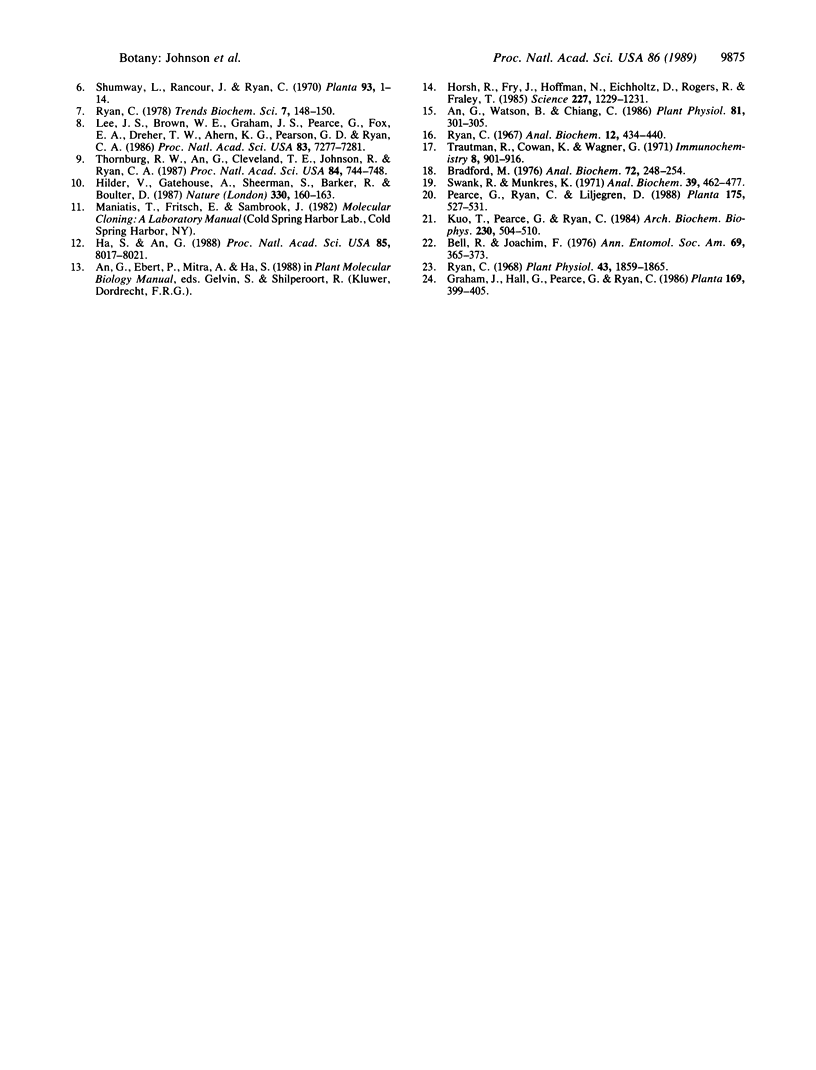
Images in this article
Selected References
These references are in PubMed. This may not be the complete list of references from this article.
- A simple and general method for transferring genes into plants. Science. 1985 Mar 8;227(4691):1229–1231. doi: 10.1126/science.227.4691.1229. [DOI] [PubMed] [Google Scholar]
- An G., Watson B. D., Chiang C. C. Transformation of Tobacco, Tomato, Potato, and Arabidopsis thaliana Using a Binary Ti Vector System. Plant Physiol. 1986 May;81(1):301–305. doi: 10.1104/pp.81.1.301. [DOI] [PMC free article] [PubMed] [Google Scholar]
- Bradford M. M. A rapid and sensitive method for the quantitation of microgram quantities of protein utilizing the principle of protein-dye binding. Anal Biochem. 1976 May 7;72:248–254. doi: 10.1016/0003-2697(76)90527-3. [DOI] [PubMed] [Google Scholar]
- Graham J. S., Pearce G., Merryweather J., Titani K., Ericsson L. H., Ryan C. A. Wound-induced proteinase inhibitors from tomato leaves. II. The cDNA-deduced primary structure of pre-inhibitor II. J Biol Chem. 1985 Jun 10;260(11):6561–6564. [PubMed] [Google Scholar]
- Graham J. S., Pearce G., Merryweather J., Titani K., Ericsson L., Ryan C. A. Wound-induced proteinase inhibitors from tomato leaves. I. The cDNA-deduced primary structure of pre-inhibitor I and its post-translational processing. J Biol Chem. 1985 Jun 10;260(11):6555–6560. [PubMed] [Google Scholar]
- Gustafson G., Ryan C. A. Specificity of protein turnover in tomato leaves. Accumulation of proteinase inhibitors, induced with the wound hormone, PIIF. J Biol Chem. 1976 Nov 25;251(22):7004–7010. [PubMed] [Google Scholar]
- Ha S. B., An G. Identification of upstream regulatory elements involved in the developmental expression of the Arabidopsis thaliana cab1 gene. Proc Natl Acad Sci U S A. 1988 Nov;85(21):8017–8021. doi: 10.1073/pnas.85.21.8017. [DOI] [PMC free article] [PubMed] [Google Scholar]
- Kuo T. M., Pearce G., Ryan C. A. Isolation and characterization of proteinase inhibitor I from etiolated tobacco leaves. Arch Biochem Biophys. 1984 May 1;230(2):504–510. doi: 10.1016/0003-9861(84)90430-2. [DOI] [PubMed] [Google Scholar]
- Lee J. S., Brown W. E., Graham J. S., Pearce G., Fox E. A., Dreher T. W., Ahern K. G., Pearson G. D., Ryan C. A. Molecular characterization and phylogenetic studies of a wound-inducible proteinase inhibitor I gene in Lycopersicon species. Proc Natl Acad Sci U S A. 1986 Oct;83(19):7277–7281. doi: 10.1073/pnas.83.19.7277. [DOI] [PMC free article] [PubMed] [Google Scholar]
- Pearce G., Sy L., Russell C., Ryan C. A., Hass G. M. Isolation and characterization from potato tubers of two polypeptide inhibitors of serine proteinases. Arch Biochem Biophys. 1982 Feb;213(2):456–462. doi: 10.1016/0003-9861(82)90571-9. [DOI] [PubMed] [Google Scholar]
- Ryan C. A. Quantitative determination of soluble cellular proteins by radial diffusion in agar gels containing antibodies. Anal Biochem. 1967 Jun;19(3):434–440. doi: 10.1016/0003-2697(67)90233-3. [DOI] [PubMed] [Google Scholar]
- Ryan C. A. Synthesis of chymotrypsin inhibitor I protein in potato leaflets induced by detachment. Plant Physiol. 1968 Nov;43(11):1859–1865. doi: 10.1104/pp.43.11.1859. [DOI] [PMC free article] [PubMed] [Google Scholar]
- Swank R. T., Munkres K. D. Molecular weight analysis of oligopeptides by electrophoresis in polyacrylamide gel with sodium dodecyl sulfate. Anal Biochem. 1971 Feb;39(2):462–477. doi: 10.1016/0003-2697(71)90436-2. [DOI] [PubMed] [Google Scholar]
- Thornburg R. W., An G., Cleveland T. E., Johnson R., Ryan C. A. Wound-inducible expression of a potato inhibitor II-chloramphenicol acetyltransferase gene fusion in transgenic tobacco plants. Proc Natl Acad Sci U S A. 1987 Feb;84(3):744–748. doi: 10.1073/pnas.84.3.744. [DOI] [PMC free article] [PubMed] [Google Scholar]
- Trautman R., Cowan K. M., Wagner G. G. Data processing for radial immunodiffusion. Immunochemistry. 1971 Oct;8(10):901–916. doi: 10.1016/0019-2791(71)90429-0. [DOI] [PubMed] [Google Scholar]





